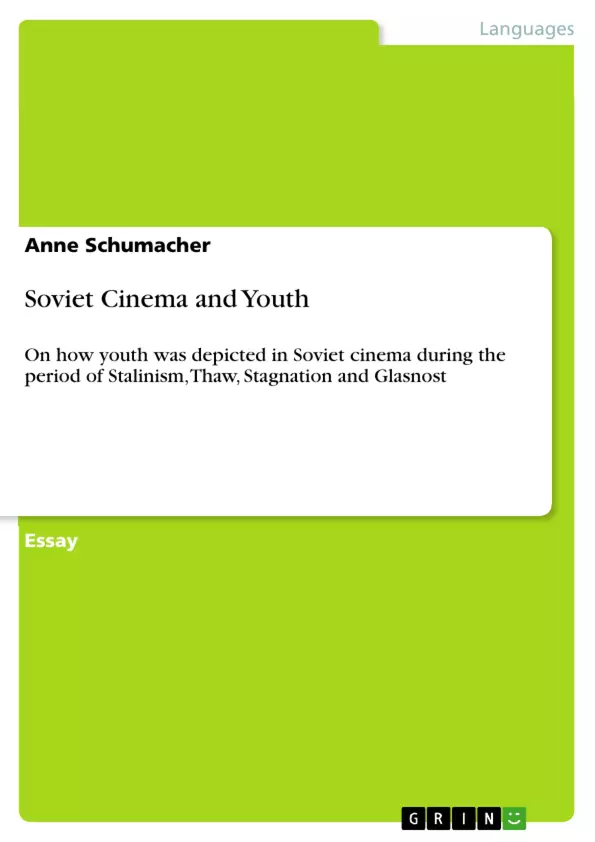The history of the Soviet Union has shown that the light heartedness, the insouciance and the naive
optimism, which distinguishes children and adolescents from their parents and grandparents, can
disappear easily in times of war and oppression.
With the takeover of Josef Stalin in the late 1920s, the beginning of one of the darkest periods of
the Soviet Union was announced. Stalin’s totalitarian regime was marked by a rigid
authoritarianism and a widespread use of terror in form of the so-called purges, which would not
end until his death in March 1953.1 In addition to the Stalinist regime, Soviet Union suffered under
the consequences of the Eastern Front War (World War II), in which Soviet Union lost thousands
and thousands of men, and the ensuing Cold War. This more than twenty years of terror, purges
and war was a time in which children rarely had time to be children, and adolescents very seldom
had time for leisure and jauntily dreaming, in short to be young. Nor was it a time in which their
personal suffering, like the suffering of their parents and grandparents, appeared on screen.
Nevertheless was youth represented in Stalinist movies, a lot of young people were showed riding
tractors and starred the popular Stalinist musicals. “Youth was the natural supporter of the new
regime“ and the older generations “could be treated with circumspection” (Gillenspie, 2003, p.
164). Though it was never one person only the starred a Stalinist movie, the hero was the collective
and individual miseries and fates never played a role in Stalinist cinema. Problems of the youth
were hushed up, like all other form of social malaise (Gillespie, 2003, p. 157). Pain and suffering
did barely exist officially and were not represented in the movies of the Stalin era, which were
meant to serve as an instrument of the communist ideology. [...]
Inhaltsverzeichnis (Table of Contents)
- Soviet Cinema and Youth
- Stalinist Cinema
- The Thaw
- I Walk Around Moscow
- Ilichs Gate
- And What if it is Love?
- July Rain
Zielsetzung und Themenschwerpunkte (Objectives and Key Themes)
This essay examines the portrayal of youth in Soviet cinema during four distinct periods: Stalinism, the Thaw, Stagnation, and Glasnost. It explores how the changing political and social landscape of the Soviet Union influenced cinematic representations of young people, highlighting the themes of societal expectations, individual expression, and the evolving relationship between generations.
- The influence of Soviet political ideology on the portrayal of youth in cinema.
- The emergence of youthful agency and individual expression in post-Stalinist cinema.
- The role of family dynamics and generational conflict in Soviet films.
- The exploration of social issues, such as love, responsibility, and individual freedom, through the lens of youth.
- The impact of cultural influences, such as international music and fashion, on the depiction of youth in Soviet cinema.
Zusammenfassung der Kapitel (Chapter Summaries)
The essay begins with an analysis of Stalinist cinema, where youth is portrayed as a homogenous collective supporting the new regime. The focus on collective effort overshadows individual experiences and anxieties. The essay then delves into the period of the Thaw, highlighting the reappearance of youth on the screen as a generation seeking individual expression and grappling with a changing world.
The essay examines key films such as "I Walk Around Moscow" and "Ilichs Gate," which showcase the optimistic atmosphere of the Thaw, while also exploring themes of individual responsibility and generational differences. It analyzes how these films, while portraying youthful energy and idealism, also hint at the limitations and complexities of the era. The essay further explores two additional films, "And What if it is Love?" and "July Rain," which further illustrate the themes of youthful agency and the evolving relationship between generations. These films also explore the influence of international culture and trends on the depiction of Soviet youth.
Schlüsselwörter (Keywords)
This preview delves into the representation of youth in Soviet cinema, focusing on key themes of political ideology, individual expression, generational conflict, social issues, and cultural influences. It analyzes key films, including "I Walk Around Moscow," "Ilichs Gate," "And What if it is Love?," and "July Rain," to demonstrate how Soviet filmmakers captured the dynamic and evolving relationship between youth and society during a pivotal period in Soviet history.
- Citation du texte
- Anne Schumacher (Auteur), 2013, Soviet Cinema and Youth, Munich, GRIN Verlag, https://www.grin.com/document/267313



